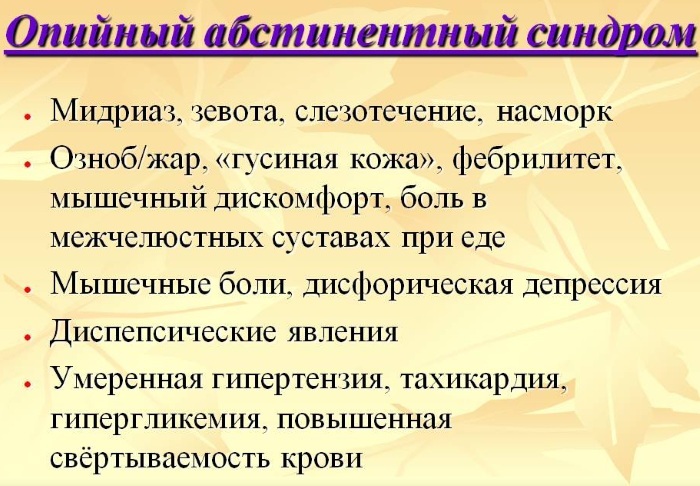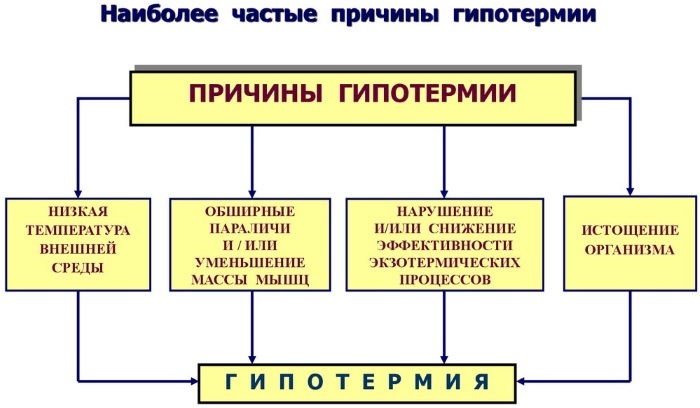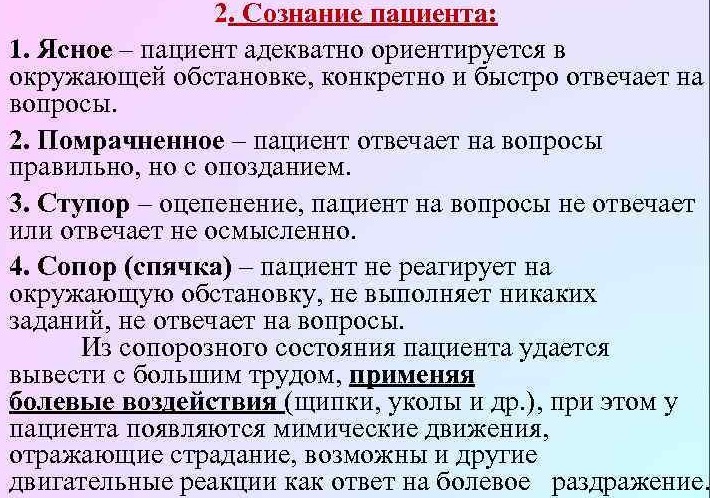Prolonged crush syndrome, or crash syndrome, occurs when excess pressure builds up inside an enclosed muscle space in the body. This occurs as a result of bleeding or swelling after an injury, when an obstacle is created to blood flow to the affected tissues.
Record content:
- 1 Views
- 2 Stages and degrees
- 3 Symptoms
- 4 Reasons for the appearance
- 5 Diagnostics
- 6 When to see a doctor
- 7 Prophylaxis
-
8 Treatment methods
- 8.1 First aid
- 8.2 Medications
- 8.3 Traditional methods
- 8.4 Other methods
- 9 Possible complications
- 10 Prolonged Compression Syndrome Video
Views
Prolonged pressure syndrome is a condition in which the blood supply to tissues below the site of injury is disrupted. The tissue begins to experience oxygen starvation, necrosis gradually develops, while toxic substances are released into the body.
Often, when squeezed, muscles are torn, a bone fracture occurs, blood vessels are damaged, and bleeding is disturbed. A person develops a long-term pain syndrome, leading to traumatic shock.
Compression of organs has two types:
- Prolonged crush syndrome. The condition occurs under the influence of prolonged compression of soft tissues. In this case, the systems of the body can be disrupted: the central nervous system, the vessels of the cortex of the kidneys, blood circulation, there is a deficiency of oxygen in the tissues.
- Positional Compression Syndrome. This is a common type of syndrome, when a violation of soft tissues and blood circulation occurs due to squeezing of a limb from an uncomfortable position. This condition often occurs in persons in the case of severe alcohol intoxication, drug poisoning, fainted. In this case, there is no pain shock, and after waking up, the person feels severe numbness, loss of sensitivity in places of squeezing.
Stages and degrees
Doctors distinguish 4 degrees of crash syndrome:
- Lightweight, at which the pressure on the limbs occurred for no more than 4 hours.
-
Moderate severity. Compression of 1 limb and 2 segments of different limbs lasted no more than 6 hours.
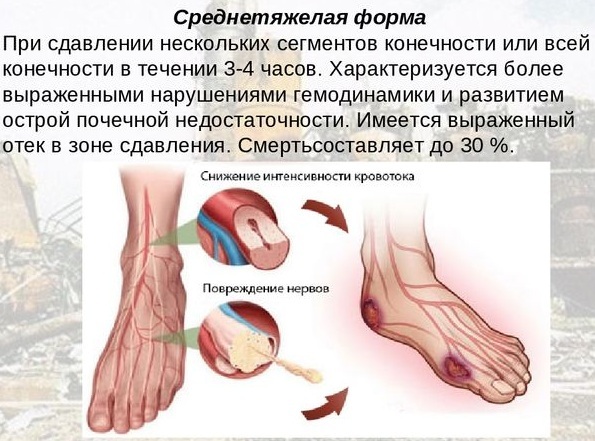
-
Severe degree. In this case, pressure should be applied to both upper or lower extremities for 8 hours.
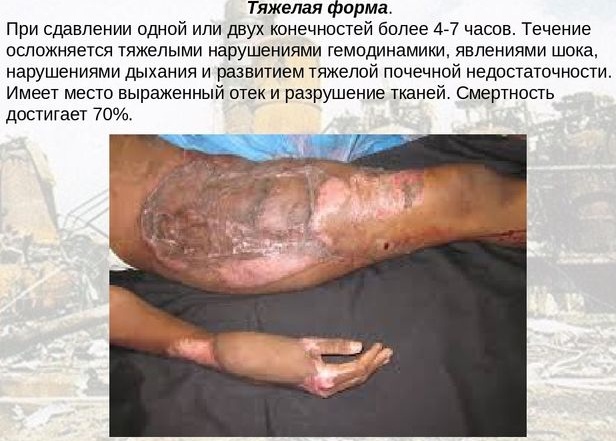
-
Particularly severe degree. It comes after 8 hours of squeezing. As a rule, two days after the discovery of the victim, death occurs.
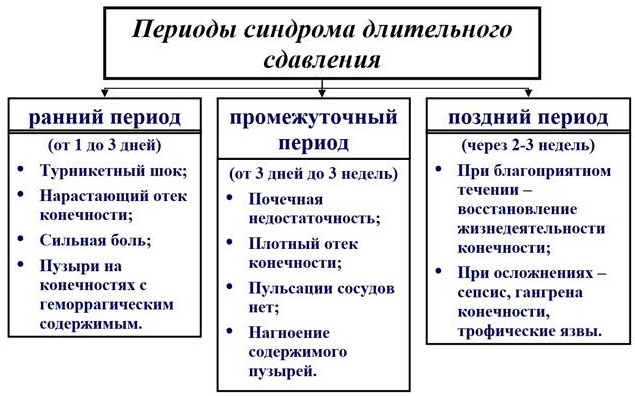
With positional squeezing syndrome, doctors distinguish several periods:
- Spicy. Lasts from the beginning of the lesion up to several days. The victim in this case is in a state in which the cardiac activity, the respiratory system, the kidneys, and the liver are impaired.
- Early. The patient, after the return of consciousness, within 1-2 days, complains of pain at the site of the lesion, impaired movement, loss of sensitivity. At the same time, the pulsation of peripheral vessels is reduced, hematomas, abrasions, and edema are determined on the skin.
- Intermediate. In this case, signs of kidney damage appear, traumatic toxicosis develops, signs of blood clotting appear. These signs appear on the 5-25th day in the absence of timely treatment.
- Recovery. Occurs 2-3 months after the defeat.
- Period of residual effects. It can last up to 3-4 years. It is characterized by signs: muscle weakness and reduced sensitivity, impaired renal function, manifestation of paresthesia or numbness of the affected organ.
Symptoms
The clinical picture of a crash syndrome depends on several reasons:
- which organ was subjected to pressure;
- external compression force;
- organ damage area;
- time spent under the rubble.

So, victims of a blockage or an accident who have suffered compression of both legs at hip level have more severe stages of the lesion and a worse prognosis than those who suffered from hand squeezing at the level forearms.
Squeeze syndrome is a condition in which muscle cells break down and rupture. At the same time, it releases myoglobin, which is converted into metmyoglobin and, finally, acidic hematin, which is released into the circulation.
Muscles contain potassium, magnesium, phosphates, acids, enzymes. Although these substances are essential for the functioning of cells, they become toxic when they enter the bloodstream in large quantities.
The muscles become severely swollen, stiff, cold, numb and necrotic. The kidneys also tend to swell and increase in volume. The released potassium from the circulation causes an irregular heartbeat. A person's gas exchange is disturbed, affecting pulmonary edema, which often leads to shock.
At the time a person is discovered, his condition may be severe or satisfactory:
- If after compression a little time has passed, then the affected limb becomes edematous, the skin is cold and pale, the pulsation is weak or absent.
- If a person has spent more than 6 hours under the rubble, then the symptoms will be extremely severe. The affected areas of the body become red with a bluish tinge, severe swelling appears, motor function, vascular pulsation is absent, the slightest change in body position causes a strong pain.
Reasons for the appearance
Prolonged pressure syndrome is a condition that occurs after prolonged exposure to one or more body parts under the oppression of a heavy object.
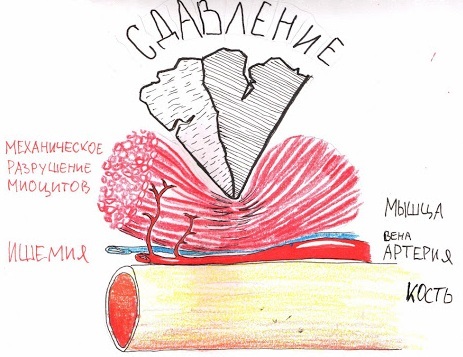
The development of the condition is due to factors:
- the duration of the pain syndrome;
- overflow of plasma from blood vessels into soft tissues, which occurred due to an increase in capillary permeability under the influence of the gravity of the pressing object;
- the entry into the bloodstream of toxic substances.
Diagnostics
The definition of pathology is based on human complaints, physical examination.
To clarify the diagnosis, the patient is prescribed:
- general urine analysis (analysis cost from 300 rubles);
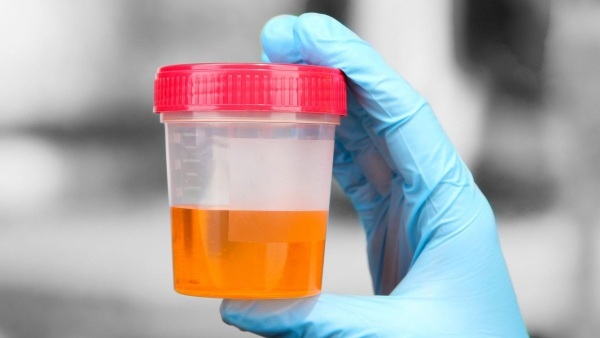
- general blood test (cost from 100 rubles);
- a blood test for myoglobin (cost from 340 rubles);
- assessment of renal function (cost of screening 570 rubles).
X-rays are prescribed in case of limb fracture. The cost of the procedure depends on the organ to be examined, the price starts from 350 rubles.
When to see a doctor
At the slightest suspicion of squeezing syndrome, you should consult a traumatologist. This can happen not only after an accident, but also after heavy alcohol intoxication. Additionally, you may need to consult a nephrologist, cardiologist and dermatologist. In extreme cases, the help of a surgeon will be required.
Prophylaxis
No person is immune to injury. With some, the body copes easily, others require long-term treatment and recovery.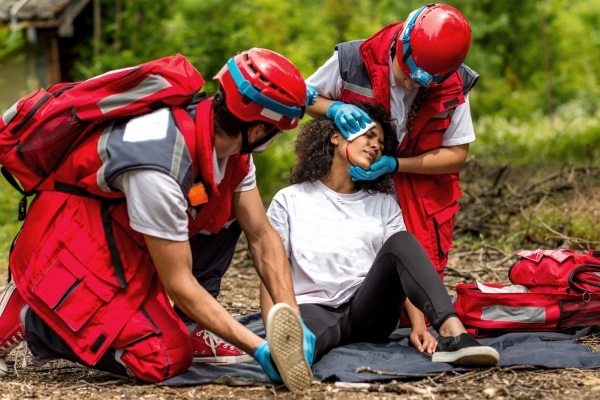
Injuries when squeezing the body or individual limbs most often people get when working with mechanisms, in underground mines, ground transport accidents, in the event of an explosion at home from household gas. In other cases, this happens for reasons beyond human control, for example, an earthquake, collapse of buildings, falling under a rockfall in the mountains.
Quite often, organ injury occurs as a result of an improper lifestyle. Drunkenness, drug addiction are factors that provoke injuries.
Preventive measures include:
- compliance with industrial safety regulations;
- strict observance of traffic rules, mandatory use of seat belts;
- getting rid of bad habits and psychological addictions.
Treatment methods
Prolonged squeezing involves carrying out therapeutic actions aimed primarily at reducing the pain threshold. So, at the initial stage, with a crash syndrome, an anesthetic of a narcotic or non-narcotic nature is administered. If necessary, with the syndrome, cardiovascular drugs, antispasmodic and antihistamines are added.
First aid
If the victim is found under the rubble, the crushed limbs cannot be released immediately. The primary measure is the imposition of a tourniquet above the injury site, and only after that the person is released. The rapid release of the limb will allow toxic products from tissue damage to enter the bloodstream.
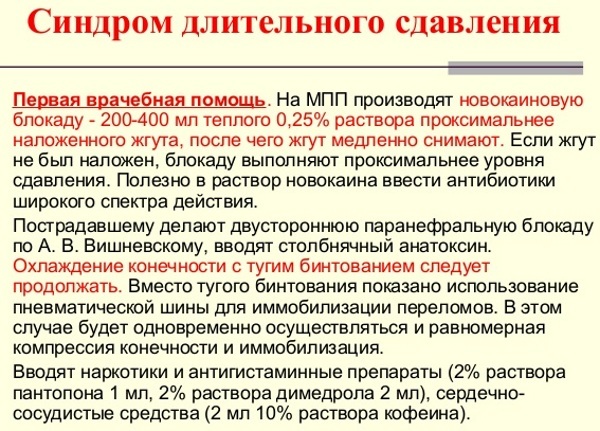
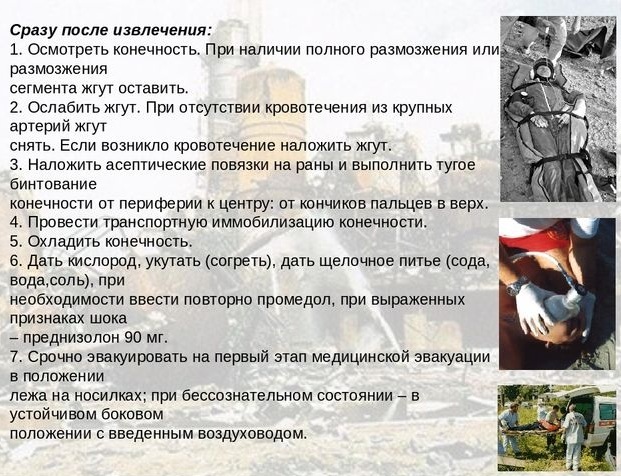
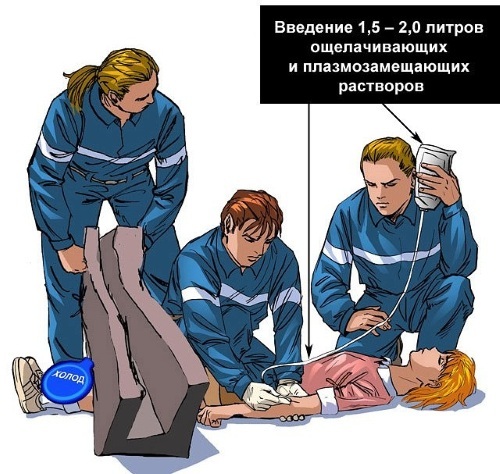
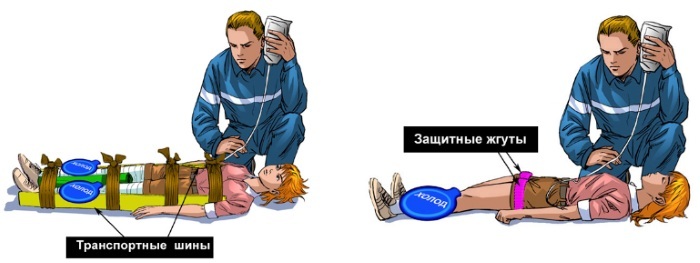
- In case of injury to the limbs, a person should be freed from shoes and clothes, the damaged area should be tightly bandaged with a splint, and cold should be applied.
- If there are open wounds, they should be cleaned and sterile dressings applied.
- The patient at this moment needs analgesics, if there is no wound in the abdomen, then you can give a drink.
Then the victim is delivered to a medical facility as soon as possible. The time of application of the tourniquet should be fixed: in the cold period, it can last no more than 1 hour, and in the summer period - no more than half an hour after application.
Medications
During the transportation of the victim, infusion therapy is carried out, based on the introduction into the bloodstream of solutions of trental or glucose, or sodium bicarbonate. In parallel, sedatives are administered.
Upon arrival at the hospital, therapeutic actions are carried out depending on the degree of damage:
| Treatment type | What is it aimed at | Drugs | Price in rub. |
| Central vein catheterization | To facilitate the administration of intravenous infusions in the future | ||
| Intravenous infusion | To reduce intoxication | Fresh frozen plasma | 3,000 per 100 ml |
| Hemodez | RUB 54 for 200 ml | ||
| Reopolyglyukin | RUB 100 for 200 ml | ||
| Plasmapheresis | Drawing blood, cleaning it and returning it back to the bloodstream | ||
| Hyperbaric oxygenation | To increase the oxygen capacity of the blood | ||
| The use of sorbents | Cleansing the body | Enterodesis | 104 |
| Activated carbon | 10 | ||
| Medications | |||
| Pain relievers | Tramadol | 90 | |
| Ketonal | 80 | ||
| Antispasmodics | Analgin | 54 | |
| No-shpa | |||
| Glucocorticoids | Solu-Decorin | 3 500 | |
| Sedatives | Diazepam | 270 |

Recovery of motor functions is not always possible. Patients at any stage of treatment may need an operation to suture nerve trunks, remove necrotic areas of tissues, muscles, and in the worst case, amputation of limbs may be required.
Traditional methods
Squeeze Syndrome is damage caused by external influences. It is always accompanied by a violation of the integrity of tissues, a subsequent change in functions, and possibly anatomical structures. Therefore, it is very important to pay attention to various natural substances, biologically active preparations in the process of rehabilitation.
| Name of the drug | Effects on the body | How to use |
| Vitamins | ||
| Vitamin B15 | Increases muscle glycogen synthesis, Helps carry oxygen to tissues | Take 1 capsule daily |
| Vitamin E | The drug with antihypoxic action, regulates oxidative processes, restores muscles after dystrophy | Take 1 capsule with a meal, 1 time per day |
| Vitamin C | Accelerates the recovery of the body | 1 tab. 1-2 times a day |
| Adaptogens | ||
| Ginseng | Stimulates metabolism, | It is taken in 2-3-5 ml for 3 weeks, half an hour before meals |
| Chinese lemongrass | Has a tonic effect on the central nervous system, regulates the cardiovascular and respiratory systems | Take 20-30 drops twice / day for 4-5 weeks |
| Platan-leaved sterculia | Restores muscle tone | Taken twice / day, 20 drops for 3 weeks |
| Pantokrin | The drug is made on the basis of deer antlers. Provides support to the body in neurasthenic conditions, accelerates recovery. |
Dosage: 30–35 drops daily half an hour before meals, twice a day. Reception course: 2-3 weeks. |

Baths with the addition of calendula, juniper berries, and rosemary will help with muscle pains. To do this, wrap a bunch of herbs in cheesecloth and put them in warm water. After 10-15 minutes. infusion, you can take a bath.
To restore bone mass, better bone fusion, you can use nettle, horsetail. They provide the minerals needed for bone regeneration. Herbs can be brewed as a tea and consumed several times a day. You should also include in the diet mineral supplements: calcium, zinc, boron and silica.
Essential oils help relieve muscle pain. They have an analgesic effect, relieve tension, increase blood flow to the affected areas.
For massage, you can use oils:
- peppermint essential oil;
- lavender;
- eucalyptus;
- sandalwood.
When using, it should be remembered that they strongly affect the skin, because their composition is close to sebum. Essential oils should be mixed with a carrier oil before use. Olive oil works well for this purpose. Before the massage, both oils are mixed in proportion: 10-12 drops of essential oil should be added to 30 ml of carrier oil.
Other methods
Rehabilitation after injury should be carried out according to an individual program.
But some of the recovery steps are the same for everyone:
- Increased tone and elasticity of muscle tissue. Before you start exercising, you should make sure that the muscles are ready for stress.
- Elimination of edema, vascular changes. These symptoms are characteristic of the limbs after prolonged immobility.
- Restoration of motor functions. The process of additional classes should be progressive and not involve excessive loads.
- General strengthening methods of restoring the body: the mode of staying in the air, rational nutrition, a healthy lifestyle.
The main methods of rehabilitation therapy include:
- Physiotherapy. Exercise therapy normalizes metabolism, improves the functioning of the heart system, strengthens muscles, raises tone and mood.
-
Mechanotherapy. Exercises with the help of special devices will be a good addition to exercise therapy. With their help, articular mobility, muscle activity is restored, and atrophic consequences are overcome.
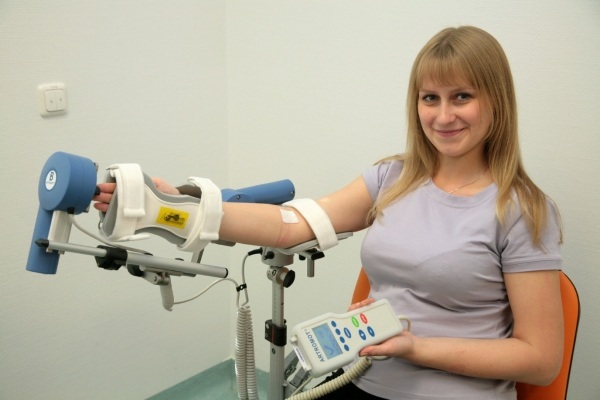
- Physiotherapy. Restoration of the working capacity of organs with the help of magnetic radiation, electric current, heat. In case of impaired motor activity, electrostimulation procedures help. Laser therapy eliminates puffiness and pain. All procedures are prescribed strictly individually.
- Massage. The most common restorative technique. Stroking, rubbing, kneading has a beneficial effect on the body, improves blood microcirculation, relieves swelling, and activates muscles. Each massage course consists of 10 sessions, which are recommended every other day or daily.
Possible complications
The longer a person remains under the influence of compression, the stronger the squeezing force, the faster critical changes occur in the body.
- During the first two days after release from compression, the victims may develop traumatic shock, pulmonary edema, heart attack.
- Three days later, an intermediate period of prolonged squeezing syndrome occurs. It lasts up to 15–20 days and depends on the severity of the injury. The state of health during this period can be very complicated. Types of complications:
- kidney damage;
- acute renal failure;
- tissue necrosis;
- accession of infections;
- development of sepsis.
- At the next stage, which can last several months, infectious complications may occur due to long-term non-healing wounds.
The outcome of the syndrome of prolonged compression largely depends on the severity of the injury, timely treatment and subsequent rehabilitation measures.
Author: Belyaeva Anna
Prolonged Compression Syndrome Video
About Prolonged Crush Syndrome:

